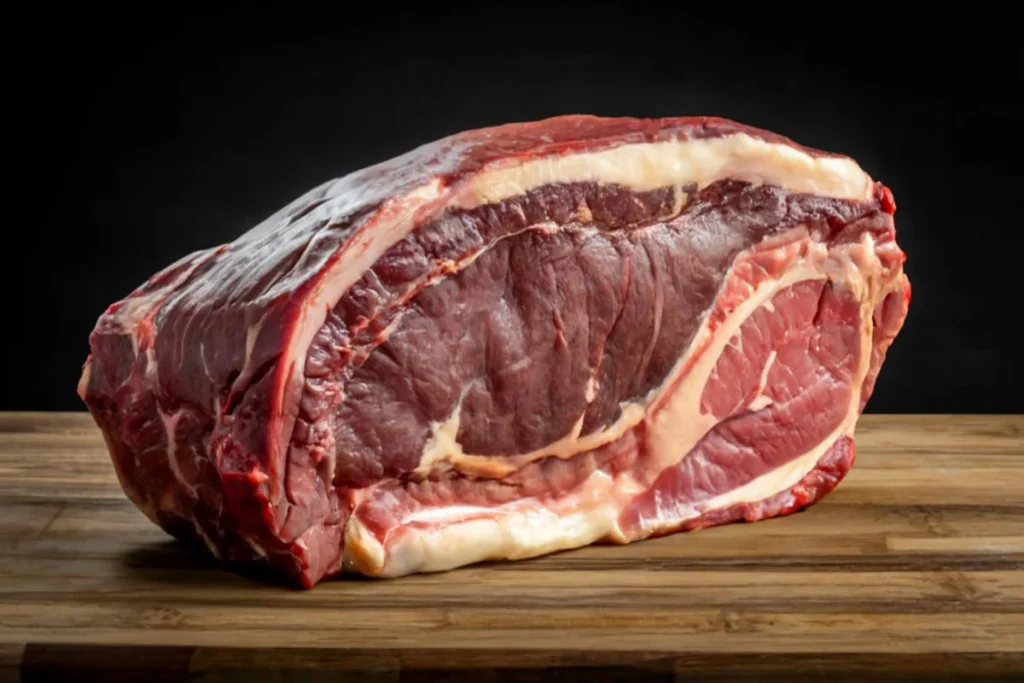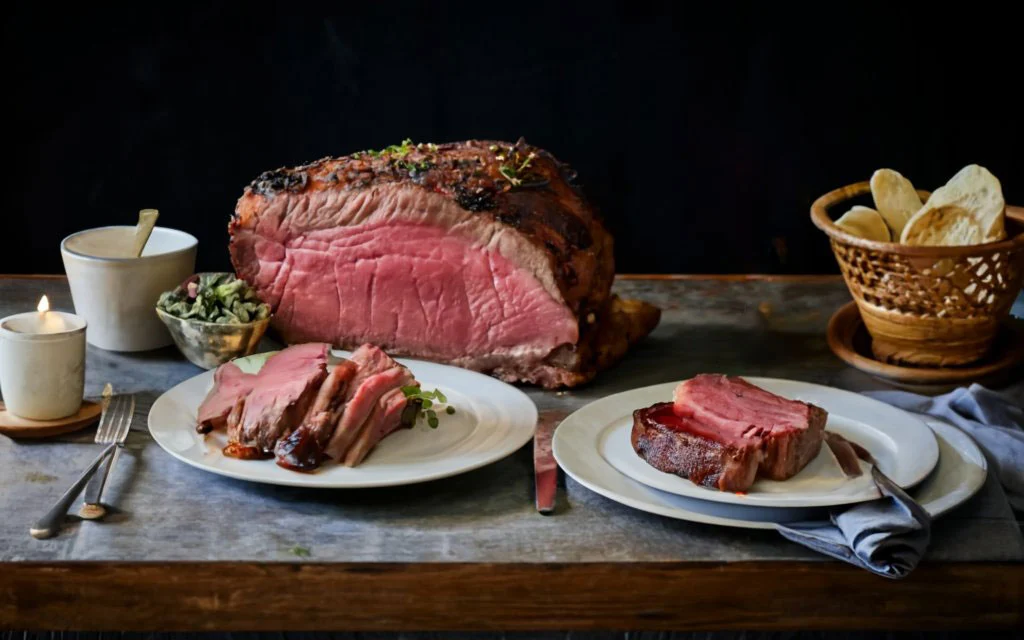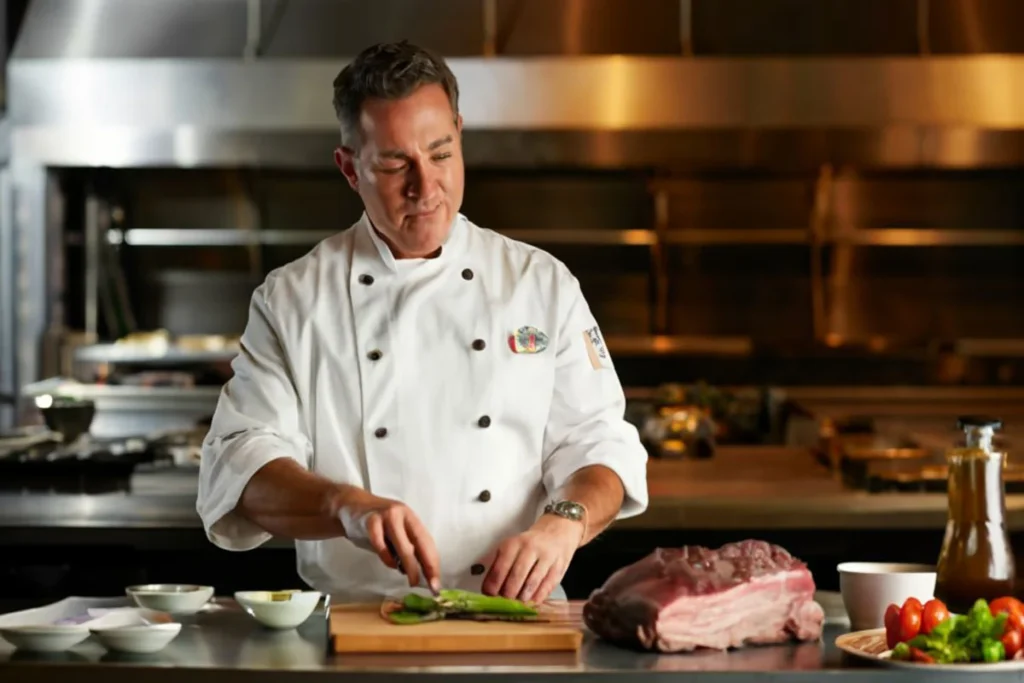In the grand arena of culinary delights, the debate of Prime Rib vs Ribeye stands tall, much like a seasoned chef pondering over the perfect cut of beef. This article slices into the heart of this debate, carving out the nuances, similarities, and stark differences that set these two esteemed cuts apart. From the historical corridors of traditional roasts to the sizzling skillets of modern steak dinners, we embark on a flavorful journey to demystify these beefy contenders. So, buckle up, dear reader, as we dive fork-first into the succulent world of prime rib and ribeye, ensuring you’re well-equipped to choose the champion of your next culinary escapade.
Introduction to the Prime Rib vs Ribeye Debate
The Prime Rib vs Ribeye Culinary Debate
Ah, the age-old question in the Prime Rib vs Ribeye debate that has flummoxed many a meat lover: Are they the same? Well, folks, we’re about to lay it all out on the table, clear as a well-aged broth. You see, both cuts hail from the same noble lineage—the rib section of our bovine buddies. Yet, they parade around the culinary world with distinct flair and flavor profiles that set them apart.
Prime Rib and Ribeye: A Comparative Overview
Let’s start with the majestic prime rib, shall we? Picture this: a grand, bone-in roast, its marbled flesh promising a tender, juicy feast. It’s the kind of dish that commands the spotlight at holiday dinners, its rich, beefy aroma wafting through the air, heralding a meal to remember.
On the flip side, we’ve got the ribeye—the prima donna of steak cuts. Whether it’s gracing your grill with its marbled beauty or sizzling in a skillet, the ribeye steak is all about that perfect balance of fat and lean, delivering a flavor that’s as bold as it is buttery.
So, as we tread further into this meaty realm, keep your forks at the ready and your appetites keen. We’re on a quest to unravel the mysteries of prime rib and ribeye, ensuring that by the end of this journey, you’ll be a connoisseur of these carnivorous delights.
Understanding Prime Rib in the Prime Rib vs Ribeye Context
Historical Context and Culinary Significance
Dive into the annals of culinary history, and you’ll find prime rib sitting royally amongst the classics. This cut isn’t just a meal; it’s a tradition, steeped in the kind of rich history that makes it a centerpiece at celebrations. Originating from the primal rib section of the cow, prime rib has been the toast of many a festive table, from grand holiday feasts to the kind of Sunday dinners that stories are made of.
Characteristics of Prime Rib
Now, in our exploration of Prime Rib vs Ribeye, let’s get up close and personal with prime rib. Imagine a cut so tender and juicy, it practically melts in your mouth. This is the magic of prime rib. Located behind the cow’s shoulder and before the lower back, this section doesn’t get much action, which means the meat is as tender as a love song. The marbling? Oh, it’s like fine art, with fat weaving through the beef, promising a flavor that’s nothing short of spectacular.
A typical USDA Prime bone-in rib roast might include ribs six through twelve, sold as a whole unit. This isn’t just meat; it’s an experience, with the ribeye, rib cap, and rib end all coming together in a symphony of flavors. And remember, the ‘prime’ in prime rib speaks more to its primo location on the cow than its USDA grade, though the two often go hand in hand.
So, when you’re pondering over that menu or mulling over your next big meal prep, keep in mind that prime rib isn’t just a dish; it’s a culinary journey, one that’s rich with history, flavor, and the kind of tenderness that can only come from a cut that’s truly top-notch.
Exploring Ribeye: The Other Half of Prime Rib vs Ribeye
Ribeye in Culinary Tradition
Stepping into the spotlight with as much gusto as a seasoned performer, the ribeye steak holds its own in the culinary world with undeniable panache. This cut is the stuff of legends among steak aficionados, revered for its rich flavor and succulent texture. A darling of the grill and a star in the skillet, the ribeye has carved its niche not just as a meal, but as a celebration of beef at its best.
Identifying Features of Ribeye
Let’s dissect the anatomy of a ribeye to truly appreciate its allure. Nestled between the sixth and twelfth ribs of the cow, this cut is a masterpiece of beef, marked by its generous marbling and a fat content that chefs and diners alike swoon over. The ribeye is often presented in three acts: the longissimus dorsi, or the eye of the steak, offering a tender, juicy bite; the spinalis, known affectionately as the ribeye cap, which is arguably the most flavorful part of the steak; and the complexus, a smaller, sometimes overlooked character that adds depth to the ribeye’s flavor profile.
Whether it’s the dramatic flair of a tomahawk steak, with its long rib bone extending like a handle, or the classic cut that fits perfectly on your plate, the ribeye is versatile, each variation offering a different experience. Cooked with a sear that locks in its flavors, or grilled to perfection, the ribeye promises a culinary adventure that’s as rich and complex as its marbling.
For those looking to delve deeper into the art of preparing this cut, our guide on how to master the perfect ribeye roast offers step-by-step instructions and expert tips.
So, as we delve deeper into the world of prime cuts, the ribeye stands out as a testament to the art of steak. It’s not just a meal; it’s an experience, one that beckons with the promise of a flavor that’s bold, buttery, and utterly unforgettable.
Prime Rib vs Ribeye: A Comparative Analysis
Anatomical Similarities and Differences in Prime Rib vs Ribeye
Now, let’s slice into the meat of the matter, shall we? Both prime rib and ribeye hail from the same regal region of the cow—the rib section. Yet, their journey from pasture to plate takes divergent paths. Picture this: prime rib, in all its glory, is like the entire orchestra, offering a symphony of flavors with the ribeye, rib cap, and rib end playing in harmony. The ribeye, on the other hand, is the soloist, captivating the audience with its focused, intense performance.
Flavor and Texture in Prime Rib vs Ribeye
When it comes to taste, both cuts sing a similar beefy tune, rich with the notes of buttery fat and succulent meat. However, the way they’re cooked can turn this duet into a battle of the bands. Prime rib, with its slow-roasted charm, offers a melody that’s deep, complex, and tender, each bite a crescendo of flavors. Ribeye, seared to perfection, delivers a punchy, bold taste, with a texture that’s as satisfying as a standing ovation.
But here’s where the plot thickens: the presence of bone and fat. These aren’t just extras in the culinary drama; they’re key players that amplify the flavor. Prime rib often comes with more fat and, occasionally, bone, adding layers to its taste profile. Ribeye, especially when bone-in, isn’t far behind, offering a richness that’s hard to beat.
So, as we compare these two titans of the table, it’s clear that while they share the same stage, their performances are uniquely their own. Whether you’re drawn to the grandeur of prime rib or the boldness of ribeye, each cut offers a culinary experience that’s as rich and varied as the world of beef itself.
Cooking Techniques for Prime Rib vs Ribeye
Recommended Cooking Methods for Prime Rib
When it comes to preparing a majestic prime rib, think of it as orchestrating a symphony: every element needs to be in perfect harmony. The key? A slow roast that envelops the meat in a warm embrace, coaxing out its flavors and tenderizing its fibers until it reaches that melt-in-your-mouth perfection. Seasoning plays first violin here, with a blend of salt, pepper, and herbs like rosemary and thyme setting the tone for a culinary masterpiece, as endorsed by the American Culinary Federation. And let’s not forget the low and slow cooking method, which ensures that every note of flavor is savored, making each bite a crescendo of taste.
Best Practices for Cooking Ribeye
Now, turn the spotlight onto the ribeye, a cut that loves the limelight of high heat. Cooking a ribeye is about capturing its essence swiftly, whether on a grill or in a skillet.The marbling, that intricate web of fat, melts into the meat, creating a texture that’s as rich as its flavor. A simple seasoning of salt and pepper might be all you need, but don’t shy away from a marinade or rub that can add layers to your dish. Remember, the ribeye’s charm lies in its ability to take center stage with minimal fuss, delivering a show-stopping taste that’s as bold as it is beautiful.
Elevate your steak with our ultimate Bang Bang sauce guide. It’s perfect for adding a spicy kick to your ribeye.
In the dance of heat and meat, prime rib and ribeye each have their choreography. Craving slow-cooked prime rib or quick-seared ribeye? Mastering these techniques turns meals into sensory feasts.
Nutritional and Cost Considerations
Health Implications of Each Cut
In the Prime Rib vs Ribeye debate, both cuts offer significant protein for muscle health. They also bring a lot of fat, especially saturated fat, which can be tricky for heart health.. The flavorful marbling in these cuts also increases their calorie count. Thus, moderation is crucial, especially for those monitoring their waistline or cholesterol.
Economic Factors to Consider
Both prime rib and ribeye can be pricey, but prime rib usually costs more. Its large size and whole roast sale contribute to its higher price.. However, the experience and sheer volume of meat can make it worth the splurge for special occasions. Ribeye offers flexibility with portion control, potentially easing your budget despite its higher price.
Choosing between prime rib and ribeye involves more than taste. It’s about balancing nutrition and budget. Understanding these aspects ensures your choice meets both palate and health goals.
Frequently Asked Questions
Why is prime rib so expensive?
Prime rib earns its hefty price tag for a few reasons. It’s a large, sought-after cut with the cow’s most tender and flavorful parts. Its preparation, often reserved for special occasions and holiday feasts, adds to its allure. The high price of this exquisite cut stems from its high demand and scarcity, as cows have limited ribs. So, when you’re indulging in prime rib, you’re not just paying for the meat; you’re investing in a culinary experience.
Can you cut prime rib into ribeye steaks?
Indeed, you can turn a prime rib into ribeye steaks. This shows how closely related these two cuts are. The process involves slicing the prime rib roast into individual steaks. This way, you can enjoy this premium beef section in different forms. Whether you prefer a whole roast’s elegance or individual steaks’ appeal, prime rib is a versatile choice for various dishes.
What does “prime” in prime rib signify?
The term “prime” in prime rib might seem linked to USDA Prime grade. Yet, it mainly refers to the cut’s prime spot on the cow. While prime rib can be of USDA Prime grade, “prime” generally denotes the cut’s top quality and rib section location. For top quality, seek the USDA Prime label to ensure your prime rib has the best marbling, tenderness, and flavor.
Is prime rib the best cut of steak?
“Best” is in the eye (or taste buds) of the beholder! Prime rib, known for its luxury and rich flavor, is ideal for those seeking to impress or indulge. Its rich marbling and tender texture make it a standout at any dining table. The steak world offers a variety of cuts, each with its unique charm. Choices like ribeye, filet mignon, and sirloin cater to different tastes, cooking styles, and occasions. The best cut is the one that aligns with your personal preferences.
In the realm of Prime Rib vs Ribeye, many questions arise. With the right knowledge, you can find the ideal cut for your culinary journey. Each bite into prime rib or ribeye offers a taste of beef’s rich flavor landscape.
Conclusion
In the vast world of culinary arts, the debate between Prime Rib and Ribeye isn’t just about taste. It celebrates the rich variety of beef and its many delights. As we’ve delved into their history, structure, and cooking methods, it’s clear both cuts are cherished by meat enthusiasts.
Prime rib boasts a regal presence and sumptuous tenderness, thereby making it a highlight of holiday feasts and special occasions. Consequently, it promises to elevate any meal into a memorable event.. Ribeye, conversely, delivers a bold and flavorful experience. It’s ideal for moments when a steak craving hits, suitable for both backyard barbecues and cozy dinners at home.
Choosing between these two beef giants isn’t just about taste or how they’re cooked. It also reflects personal likes, health choices, and budget. Choosing between rich, slow-roasted prime rib or a perfectly seared ribeye guarantees a delightful experience. Both celebrate the finest beef has to offer.
Embark on your next culinary journey with the insights gained about prime rib and ribeye. Remember, the essence of cooking and dining lies in exploring the diverse flavors, textures, and experiences food offers. Choosing between prime rib and ribeye, each bite invites you to savor the culinary art and its endless possibilities.
While we’re on the topic of meats, our complete mastery guide to cooking chicken techniques can also elevate your culinary skills with poultry.


